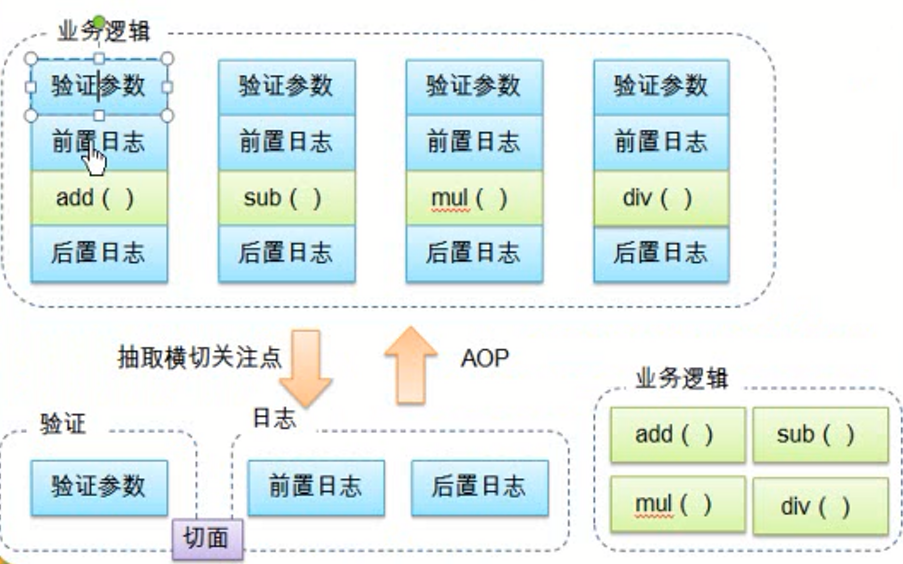AOP编程
问题:
代码混乱:
越来越多的非业务需求(日志和验证等)加入后,原有的业务方法急剧膨胀,每个方法在处理核心逻辑的同事还必须兼顾其他多个关注点。
代码分散:以日志需求为例,只是为了满足这个单一需求,就不得不在多个模块(方法)里面多次重复相同的日志代码,如果日志需求发生变化,必须修改所有模块。
先看使用动态代理:
package logan.study.aop.helloworld; public interface ArithmeticCalculator { int add(int i, int j); int sub(int i, int j); int mul(int i, int j); int div(int i, int j); }
package logan.study.aop.helloworld; public class ArithmeticCalculatorImpl implements ArithmeticCalculator { @Override public int add(int i, int j) { // TODO Auto-generated method stub int result = i + j; return result; } @Override public int sub(int i, int j) { // TODO Auto-generated method stub int result = i - j; return result; } @Override public int mul(int i, int j) { // TODO Auto-generated method stub int result = i * j; return result; } @Override public int div(int i, int j) { // TODO Auto-generated method stub int result = i / j; return result; } }
package logan.study.aop.helloworld; import java.lang.reflect.InvocationHandler; import java.lang.reflect.Method; import java.lang.reflect.Proxy; import java.util.Arrays; public class ArithmeticCalculatorLoggingProxy { //要代理的对象 private ArithmeticCalculator target; public ArithmeticCalculatorLoggingProxy(ArithmeticCalculator target){ this.target = target; } public ArithmeticCalculator getLoggingProxy(){ ArithmeticCalculator proxy = null; //代理对象由哪一个类加载器加载 ClassLoader loader = target.getClass().getClassLoader(); //代理对象的类型,即其中有哪些方法 Class [] interfaces = new Class[]{ArithmeticCalculator.class}; //当调用代理对象其中的方法时,该执行的代码。 InvocationHandler h = new InvocationHandler() { /** * proxy:正在返回的那个对象,一般情况下,在invok方法中都不使用该对象 * method:正在被调用的方法 * args:调用方法时传入的参数 */ @Override public Object invoke(Object proxy, Method method, Object[] args) throws Throwable { // TODO Auto-generated method stub String methodName = method.getName(); //日志 System.out.println("The method "+ methodName + "begin with " + Arrays.asList(args)); //执行方法 Object result = method.invoke(target, args); //日志 System.out.println("The method " + methodName + "end with result = " + result); //返回 return result; } }; proxy = (ArithmeticCalculator) Proxy.newProxyInstance(loader, interfaces, h); return proxy; } }
package logan.study.aop.helloworld; public class Main { public static void main(String[] args) { // TODO Auto-generated method stub ArithmeticCalculator target = new ArithmeticCalculatorImpl(); ArithmeticCalculator proxy = new ArithmeticCalculatorLoggingProxy(target).getLoggingProxy(); int result = proxy.add(1, 2); System.out.println("-->"+result); result = proxy.div(8, 2); System.out.println("-->"+result); } }
返回的结果:
The method addbegin with [1, 2] The method addend with result = 3 -->3 The method divbegin with [8, 2] The method divend with result = 4 -->4
但是使用动态代理比较麻烦,有没有更简单的方法来实现呢?
AOP(Aspect-Oriented-Programming,面向切面编程)是一种新的方法论,是对传统OOP(Object-Oriented-Programming,面向对象编程)的补充。
AOP的主要编程对象是切面(Aspect),而切面是模块化横切关注点。
在应用AOP编程时,仍然需要定义公共功能,但是可以明确地定义这个功能在哪里,以什么方式应用,并且不必修改受影响的类,这样一来,横切关注点就被模块化到特殊的对象(切面)里。
AOP好处:
-每个事物逻辑错位与一个位置,代码不分散,便于维护和升级
-业务模块更简洁,只包含核心的业务代码

AOP术语
切面(Aspect):横切关注点(跨越应用程序多个模块的功能)被模块化的特殊对象。
通知(Advice):切面必须要完成的工作。
目标(Target):被通知的对象。
代理(Proxy):向目标对象应用通知之后创建的对象。
连接点(Joinpoint):程序执行的每个特定位置:如类某个方法调用前,调用后,方法抛出异常等等,连接点由两个信息确定:方法表示的程序的执行点,相对点表示的方位,例如ArithmeticCalculator#add()方法执行前的连接点执行点为ArithmeticCalculator#add();方位为该方法执行前的位置。
切点(pointcut):每个类都拥有多个连接点,例如:ArithmethicCalculator的所有方法实际上都是连接点,即连接点是程序类中客观存在的事务,AOP通过切点定位到特定的连接点。类比:连接点相当于数据库中的记录,切点相当于查询条件,切点和连接点不是一对一关系,一个切点匹配多个连接点,切点通过org.springframework.aop.Pointcut接口进行描述,它使用类和方法作为连接点的查询条件。